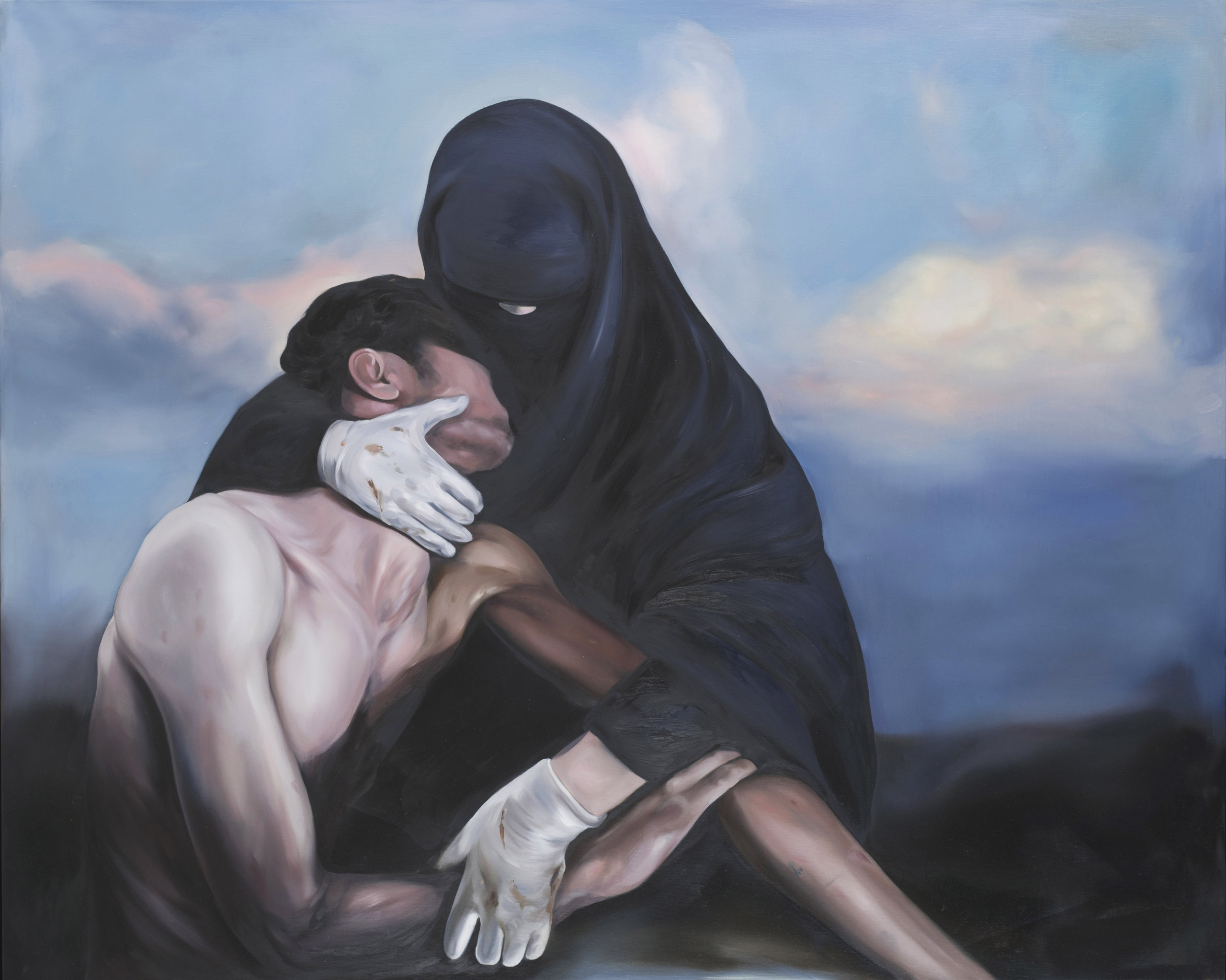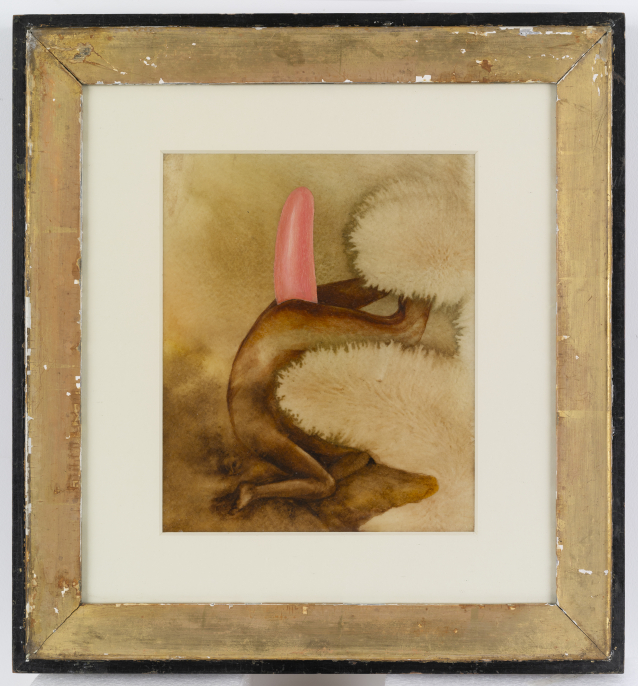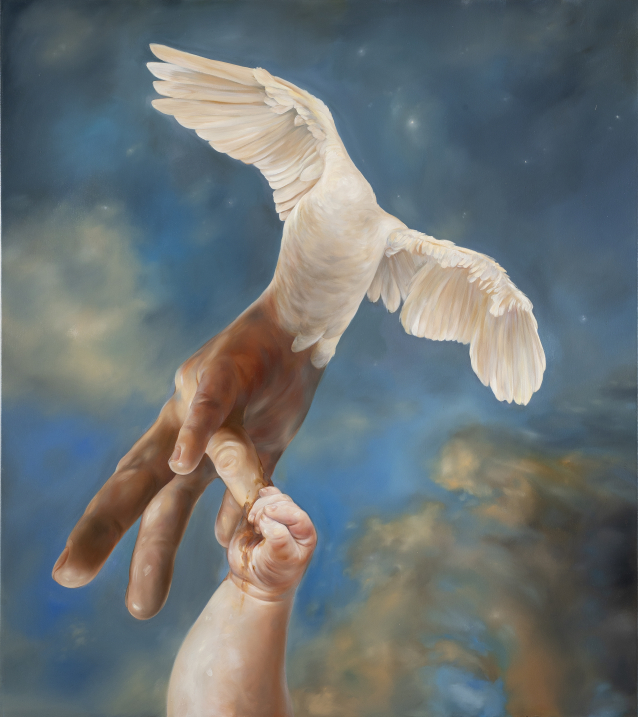
In Oda Jaune’s time
Essay
Young art critic Rose Vidal looks at the work of Oda Jaune in the light of the “time of painting”, on the occasion of the artist’s participation in the group exhibition ‘Immortelle’ in Montpellier (France).
From her London studio, bathed in sunlight, Oda’s universe is expanding as her hands play with a range of mediums, from video to sculpture to sewing. As such she produces objects that are not paintings, and yet are related to the act of painting, without which they perhaps would not exist. First and foremost, Oda Jaune is a painter. Being a painter in 2023 implies a great deal, and above all a great deal of time, different kinds of time. The most obvious of these is the long temporality of painting, which has been the subject of stories and pictures since time immemorial: it has amassed a repertory of gestures, of themes, of pictorial explorations—as well as the representations that inform our ways of looking at the world and sometimes even orient and skew the way we look. Painting examines itself, painters look at each other through their respective works, and meet or oppose each other. They have done so throughout a history that was traditionally written in the same way they paint on a canvas—stroke by stroke.
Then there is the intermediate temporality of societies, and their ways of producing art, as well as the economies they allow the artists to work within. This temporality does not entirely coincide with our lifetimes, but each artist’s existence is caught up in its currents. We might take as an example of such a temporality the recent decades during which painting experienced a decline, after its long-held prominence among the major arts. Being a painter, just as Oda Jaune was at that time, meant traversing a period when society had convinced itself it was sick of the very sight of paintings, all the while remaining a painter. Back then, art schools had turned away from the outdated paradigm of the master and his apprentices, had broken this chain of transmission of knowledge, while in exhibitions, the spotlight was shone on other art forms, other creative gestures. At that time, the kind of painting that continued to be bought and exhibited had little to do with what occupied Oda Jaune’s time and preoccupied her mind; it was no longer a time for figurative composition.
This crisis of painting as commensurate with society’s temporality may be said to be the implicit subject of the upcoming Mo.Co. exhibition “Immortal” (March 11th to May 7th), curated by Numa Hambursin, which will feature works by Oda Jaune among those of more than 110 painters. The exhibition questions the disappearance of painting from the forefront of the French art world, not only by highlighting the potential ruptures of such a withdrawal, but also by opposing the idea of disappearance with the output of artists who never stopped painting. It is an “implicit” subject because the show is explicitly about the fact that painting has always fully existed, and about restoring, at last, the visibility it has been deprived of. The issue is also to seize this opportunity to reinvent the missing links, the affinities, the transmission between fellow artists, that this visibility would have fostered by allowing painting to exist as an artistic scene.
This belated scene has yet to bear fruit and to see its implications emerge. It is waiting to be recreated, to vibrate, and to offer the critical eye new perspectives, new things to think about and grasp. The first consideration will very likely be what failed to build a scene in its time, leaving room for less porous and more singular approaches to painting. Such a configuration of the scene, as renewed by the exhibition, paradoxically allows the unique temporality of Oda Jaune and her painting to be revealed to the critical eye: the time an artist spends in the studio creating.
This time is separate from the polyphony and discussions generated by the string of concomitant and successive exhibitions that punctuate the life of a scene, and it lies in the extended dialogue between the artist and her works, as played out in her own research. This third rhythm is written out in singular, often reflexive pronouns. The word “immortal” is no doubt painting’s snub to all the voices that claimed they would dance on its grave, or even a snub to the idea of a “rebirth” of painting. Painting never died, and neither did the announcement or the idea of its disappearance affect the intimacy of the studio, in which Oda Jaune has been conducting her research without ever having been stopped from living through her paintings or from inhabiting them.
Through Oda Jaune’s paintings, the “immortal” painting is embodied in peculiar shapes and is progressively fleshed out as she creates new images, observing life—its visual effects, its materials, its colors, uncertainties and shadows, always changing—from the world to the canvas. This might be the single and intimate quest of Oda Jaune, a quest that leads her from one temporality of painting to another, in the same way one steers a boat through the waves of an ocean: seeking to extend life to painting, in painting, and through painting, as it is the only place where a body can split in two in the shape of a disproportionate mouth, and the only place where limbs and faces can intertwine to the point where their embrace gives birth to a complete chimera—a fusional, aberrant caress.
It is a desire for life to the point where
it overflows life, a desire for the body that
exceeds the body, and which is a literal chimera
This desire has no fulfillment other than in painting—and does not require any other style of painting, or any other scene, or any other hand to accomplish it. It is a desire for life to the point where it overflows life, a desire for the body that exceeds the body, and which is a literal chimera—that is to say both a monster, and a phantasy, irrational and impossible: haunting in every way. From one canvas to another, as she composes and recomposes extended possibilities for the human body, Oda Jaune gives birth to chimeras which are no longer impossible or absurd: they exist there, in the narrow space of paintings, palpable as their colors are so precisely and subtly depicted. One could touch their skin, whose every detail is revealed: the temperature, the depth that the painter delicately brushed out by mixing—a composite chimera down to the smallest detail—warm and cold colors, shades of blue, red, purple, and green. These colors that run over the skin show its thickness, and that this variable thickness makes it translucent. They show that under the thickness, the body continues to run in variable densities along to the veins, blood, hot spots, and tremors. They show that all of this is in movement, because the body and the world are in movement. They show that the light changes the transparency or the radiance of the skin—sometimes we see what is under, the vascularization, or the hardness of bone, and sometimes the skin obscures—opaque, secret, discretionary.
Sometimes the skin is a porous interface, drowned by what it envelops, bathed in the very fluids that it shelters and which cover its surface—sometimes the exterior is what bathes it in its light, the coat of a veil that changes the way we perceive its forms. The studio resembles an enclosed area, but that has a capacity for permanent expansion like the universe; each new canvas offers a new way of contemplating it. Yet it is in the ambivalence of this secret face to face, that painting, in conversation with itself, offers possibilities for connections, beyond the painters and the scenes, and beyond its own time: the work of Oda Jaune thus initiates a strange dialogue with the theme of the hortus conclusus. In this mystical space where Renaissance painters used to depict the theme of conception, the woman’s pregnant body is metaphorized by the enclosed garden. But within the architectural limits of the garden and the material limits of the canvas, an infinite something takes place, by which one plus one equals three and by which the inconceivable is conceived. Oda Jaune’s studio is the garden, allowing the unimaginable to access representation. The painter experiences the same pleasure that Hieronymus Bosch found five hundred years earlier in the exponential creation of the details of the Garden of Delights—in which each body and scene was exclusively a chimera. From Paradise to Hell, from scenes of torture to representations of pleasure, there was nothing but the delight of experiencing the body as a garden made infinite by painting.
‘Immortelle’, MO.CO, Montpellier (France), until June 4, 2023.
Rose Vidal is an artist, author and art critic. Her critical texts deal with contemporary creation, in which she also engages as a “painkiller mercenary”artist. Her first book, Chaplin, was published in 2022 (Editions Les Pérégrines). She is currently working at Palais de Tokyo in Paris with curator François Piron.


